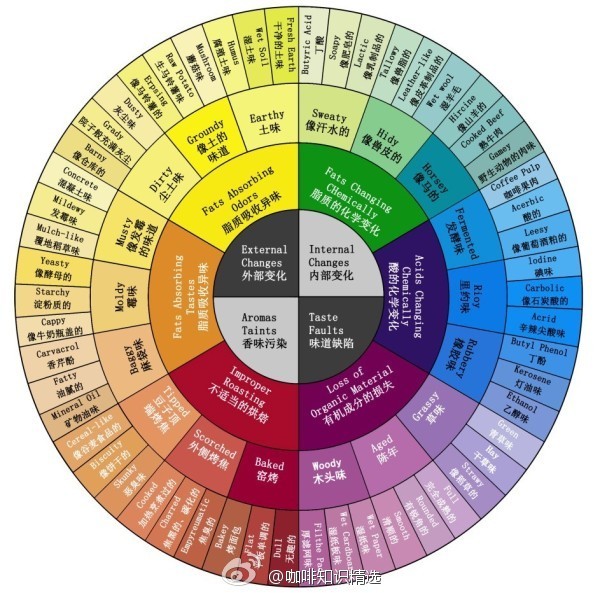Coffee flavor round baristas absolutely need to understand the chart

Friends who love boutique coffee should be no stranger to this SCAA flavor wheel, but many say they don't understand it, so let's briefly talk about the structure and expression of flavor wheel today!
The flavor wheel is divided into the negative taste spectrum on the left and the normal taste spectrum on the right.

First, let's talk about the right side of the flavor spectrum.
The content of this part is mainly about the classification and formation of coffee flavor and aroma.
Enzymatic fermentation: this is the flavor produced by fermentation during the treatment of raw beans (such as water washing, sun exposure, dense treatment), such as flower aroma, and fruit flavor.
Sugar browning sugar browning reaction: this part is the flavor produced by the caramelization reaction and Maillard reaction of coffee during roasting, such as nuts and chocolate.
Dry distilation dry distillation reaction: this part is the flavor produced by the dry distillation reaction in the coffee roasting process, such as currant, smoked flavor.
It is not very accurate to see that some people say that "the flavor wheel also represents the flavor produced by different degrees of roasting of coffee", but in fact there is a dry distillation reaction from the beginning of roasting.

Let's talk about the left half of the taste spectrum on the right.
This part is easy to understand, the basic taste sour, sweet, bitter, salty different sensory classification, it is said that the future flavor wheel will be more fresh.

Let's talk about the left flavor spectrum, let's start with the right half.
This part means that the coffee did not deal with the defective flavor during the harvest and drying stage and the flavor produced by aging during storage.
If it is not treated in time or the drying humidity and temperature is unreasonable after harvest, it will produce Rio flavor, fermentation flavor and so on. In the drying process, the coffee beans are heated too much, which will cause the decomposition of oil and produce leather and other flavors.
During the storage process after the raw bean treatment is completed, there are still some reactions inside the raw bean, the organic matter gradually changes and loses, the new bean will have the taste of grass, and after a few years of storage, due to the loss of organic matter, it will become the taste of straw and wood. at this time, the coffee is already very boring!

Finally, let's talk about the left half.
This part is the change caused by the external environment (cleanliness, humidity, etc.) during the storage and storage of raw beans, and whether the temperature is reasonable in the baking process.
In the process of raw bean treatment, the environment of raw bean drying is not clean. If it is dried on the ground, the coffee will absorb the smell around it and produce a smell such as soil, or if the humidity of the place is too high, the coffee bean may become moldy if it dries too slowly. Produce mildew.
In the process of baking, if the coffee beans are heated too fast, the coffee beans will produce smoke, carbon and other flavors. If the temperature is too slow, it will wear off the flavor of the coffee, and the taste will appear dull and boring.
The defective taste of fats changing chemically and acids changing chemically on the right is a serious flaw. In the SCAA cup test, there is a rebate of 4 points for the taste in the cup, and a slight flaw for fats absorbing odors and fats absorbing teastes on the left. 2 points will be deducted from the cup test, while improper roasting and loss of organic material do not belong to the defective flavor of raw beans, so they will not deduct the defective score, but will reduce the score in flavor performance.
Important Notice :
前街咖啡 FrontStreet Coffee has moved to new addredd:
FrontStreet Coffee Address: 315,Donghua East Road,GuangZhou
Tel:020 38364473
- Prev

A brief Analysis of the skills of Coffee Cream Flower drawing
First, the production of coffee milk foam 1, the use of Italian coffee machine (1) the use of special steel cups, the top is narrow and the lower width is easy to form a whirlpool, pour in the fresh milk until it is full. (2) first let the steam drain, then let the steam pipe nozzle form a 45-degree angle with the surface of the milk, and insert the steam pipe into the fresh milk about 1 cm. Open the steam valve and start heating, making the fresh milk whirlpool, so that the steam and fresh milk are fully mixed to produce milk bubbles. (
- Next

Analysis on the treatment process of raw coffee beans: picking-berry treatment-drying
The coffee beans we are talking about are actually the seeds of a fruit similar to cherries. Coffee trees produce berries, called coffee berries, whose bright red color means they are ripe and ready to be picked. The fruit clustered on the branches. The outer skin (exocarp) of coffee berries is thick and bitter. However, the fruit (mesocarp) inside is very sweet and has the texture of grapes. And then there's parenchyma, which is like
Related
- Beginners will see the "Coffee pull flower" guide!
- What is the difference between ice blog purified milk and ordinary milk coffee?
- Why is the Philippines the largest producer of crops in Liberia?
- For coffee extraction, should the fine powder be retained?
- How does extracted espresso fill pressed powder? How much strength does it take to press the powder?
- How to make jasmine cold extract coffee? Is the jasmine + latte good?
- Will this little toy really make the coffee taste better? How does Lily Drip affect coffee extraction?
- Will the action of slapping the filter cup also affect coffee extraction?
- What's the difference between powder-to-water ratio and powder-to-liquid ratio?
- What is the Ethiopian local species? What does it have to do with Heirloom native species?

